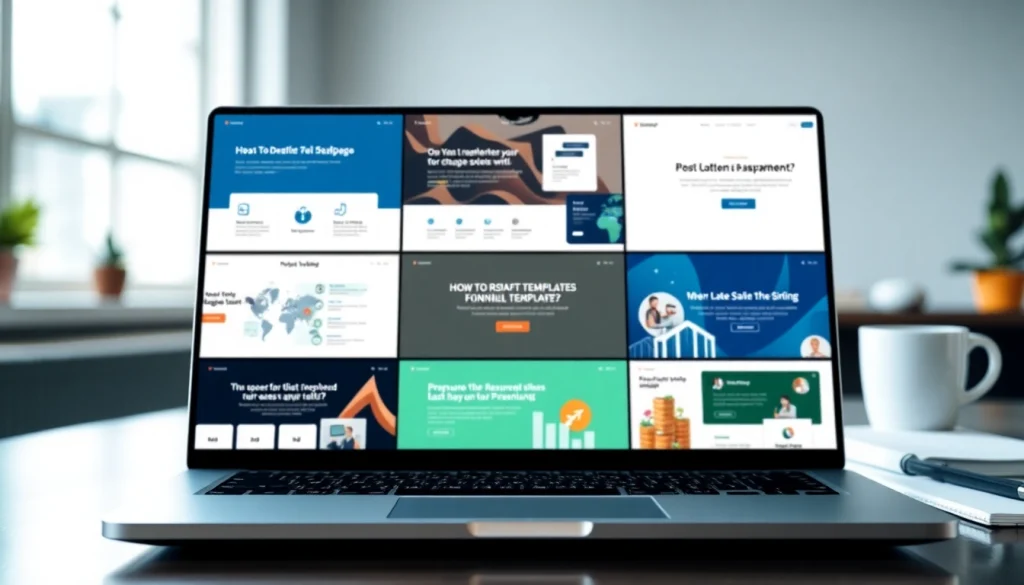
Understanding Funnel Templates
In today’s digital marketing landscape, businesses are constantly searching for efficient ways to convert leads into customers. One of the robust tools at their disposal is Funnel templates. These templates act as blueprints, guiding businesses through the critical process of customer engagement and conversion. This article delves into the world of funnel templates, exploring their importance, types, creation methods, customization options, and the future trends reshaping their effectiveness.
What are Funnel Templates?
Funnel templates are pre-designed frameworks tailored to help businesses visualize and implement their sales processes. These templates typically outline the steps necessary to guide potential customers through the sales funnel, from awareness to action (purchase). They can include various elements, such as landing pages, email sequences, and lead magnets, which all work together in a cohesive strategy.
The Importance of Funnel Templates
The importance of using funnel templates cannot be overstated. They offer a consistent process that organizations can rely on, which simplifies the conversion journey. Here are some reasons why funnel templates are crucial:
- Streamlined Processes: Funnel templates reduce the complexity involved in creating sales funnels from scratch. They offer proven paths to conversion and save time.
- Consistency: By utilizing the same funnel template, businesses can ensure a unified customer experience across various marketing channels.
- Effectiveness: Many funnel templates are designed based on industry best practices. This increases the likelihood of their success when properly implemented.
- Customization Opportunities: While templates provide a structured framework, they can easily be modified to better suit specific business needs and branding.
How Funnel Templates Work
Funnel templates work by outlining specific actions for both the business and the consumer. Typically, a funnel consists of several stages, including:
- Awareness: This is where potential customers first learn about a service or product through various channels, such as social media, ads, or organic search.
- Interest: Once aware, customers will seek more information, often landing on informative content designed to engage them.
- Decision: Here, leads evaluate options and consider making a purchase. Effective templates often include comparison guides, testimonials, or offers to facilitate this decision-making process.
- Action: Finally, this stage entails a customer making a purchase or taking the desired action, which the funnel template is designed to encourage.
Types of Funnel Templates
Understanding the various types of funnel templates can help businesses select the right one for their needs. Below are the most common types of funnel templates:
Sales Funnel Templates
Sales funnel templates are specifically designed to facilitate the sales process. These templates often include pages for product showcases, shopping carts, and order confirmations. They streamline the buying process, ensuring that users can easily navigate from product awareness to purchase.
Lead Generation Funnel Templates
Lead generation funnel templates focus on capturing potential customers’ information, such as email addresses or phone numbers. Typically, these templates include landing pages with lead magnets (e.g., free eBooks, webinars, discounts) that encourage users to provide their contact details. Once the leads are captured, they can be nurtured through email marketing and follow-ups.
Marketing Funnel Templates
Marketing funnel templates serve as comprehensive frameworks for broader marketing strategies, including content marketing, social media engagement, and customer retention efforts. These templates help outline the necessary steps for creating content that effectively moves potential customers through each stage of the marketing funnel.
Creating Effective Funnel Templates
Crafting effective funnel templates requires attention to detail and an understanding of best practices. Let’s explore how to create successful funnel templates:
Best Practices in Design
Design plays a critical role in the effectiveness of funnel templates. To create designs that convert, consider the following best practices:
- Clarity: Designs should be clean, avoiding unnecessary clutter that could distract users from the main conversion goal.
- Visual Hierarchy: Use size, color, and layout to direct attention toward key elements, such as call-to-action buttons or lead capture forms.
- Responsive Design: Ensure that templates are mobile-friendly. A significant portion of users accesses content via mobile devices.
Key Elements to Include
An effective funnel template should integrate several key elements to maximize its potential:
- Compelling Headlines: Capture attention with headlines that clearly communicate the value proposition.
- Engaging Content: Use high-quality images, videos, and copy that resonate with the target audience.
- Strong Call-to-Action (CTA): Clear and action-oriented CTAs guide users on what action to take next, whether it’s signing up for a newsletter or making a purchase.
- Social Proof: Incorporate testimonials or reviews to build trust with potential customers.
Analyzing Performance of Funnel Templates
Even the best funnel template will require ongoing analysis to ensure it performs at peak efficiency. Consider tracking the following key performance indicators (KPIs):
- Conversion Rate: Measure the percentage of visitors who complete the desired action, allowing for assessment and optimization.
- Abandonment Rate: Analyzing where users drop off in the funnel can provide insights into what elements may need improvement.
- Click-Through Rate (CTR): This metric assesses the percentage of users who click on CTAs, informing whether they are engaging with funnel elements effectively.
Customizing Funnel Templates
While templates offer a strong foundational structure, customization is essential to tailor them to specific business needs and branding. Here’s how to go about customizing funnel templates:
Tools for Customization
Whether you are a beginner or an experienced marketer, various tools can facilitate the customization of funnel templates. Some popular options include:
- Drag-and-Drop Builders: Platforms like Elementor or Wix enable users to easily modify templates using intuitive drag-and-drop interfaces.
- Graphic Design Software: Tools like Canva or Adobe Photoshop help create visually appealing graphics that enhance the overall aesthetics of the funnel.
- Email Marketing Tools: Platforms like Mailchimp or ConvertKit allow users to integrate email sequences that nurture leads through the funnel.
Tailoring to Your Audience
Customization isn’t just about the template’s look and feel; it also involves tailoring content to the target audience. To achieve this, consider:
- Customer Personas: Develop detailed profiles of your target customers, including demographics, preferences, and pain points.
- A/B Testing: Experiment with different versions of templates to identify which elements resonate best with your audience.
- Feedback Loops: Gather feedback from users regarding their experiences and adjust templates accordingly.
Examples of Customization
Real-world examples can illustrate the power of customization in funnel templates. For instance:
- A fitness coach may customize a lead generation funnel by incorporating specific fitness-related content, testimonials from training successes, and tailored CTAs for fitness assessments.
- An e-commerce store could adjust its sales funnel by using product imagery that highlights seasonal promotions and limited-time offers.
Future Trends in Funnel Templates
As technology evolves and consumer behavior shifts, so too do the trends associated with funnel templates. Staying ahead of these trends can place businesses at a significant advantage:
Emerging Design Trends
Modern consumers are increasingly drawn to visually appealing designs. Trends such as minimalism, dynamic content, and interactive elements will continue to shape the design of funnel templates. Businesses adopting these emerging trends remain relevant and engaging to prospective customers.
Technological Advances in Funnel Templates
Emerging technologies such as artificial intelligence (AI) and machine learning are set to transform how funnels are created and optimized. Features like predictive analytics can provide insights into user behavior, allowing for more proactive funnel adjustments that enhance user experience.
Preparing for Changes in User Behavior
The digital landscape is continually evolving, with shifts in user behavior influencing funnel design. Constantly monitoring trends, adapting to new preferences, and being prepared for changes in how customers engage with online content are crucial for maintaining effective funnels.
In conclusion, funnel templates serve as invaluable tools for businesses aiming to enhance their conversion rates and streamline sales processes. By understanding their design and implementation, leveraging available customization tools, and remaining aware of future trends, businesses can cultivate innovative strategies that effectively drive results. Investing time in developing and refining funnel templates is a step toward achieving marketing mastery.






